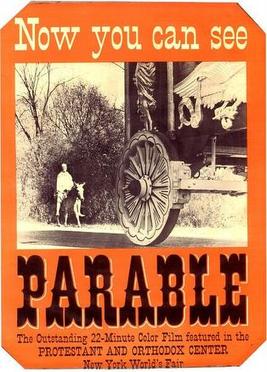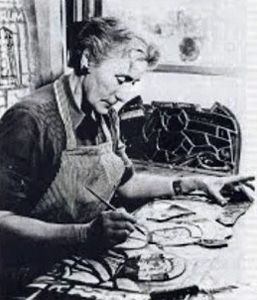Related Research Articles

Mordecai Menahem Kaplan, was a Lithuanian-born American rabbi, writer, Jewish educator, professor, theologian, philosopher, activist, and religious leader who founded the Reconstructionist branch of Judaism along with his son-in-law Ira Eisenstein. He has been described as a "towering figure" in the recent history of Judaism for his influential work in adapting it to modern society, contending that Judaism should be a unifying and creative force by stressing the cultural and historical character of the religion as well as theological doctrine.

The 1964–1965 New York World's Fair was a world's fair that held over 140 pavilions and 110 restaurants, representing 80 nations, 24 US states, and over 45 corporations with the goal and the final result of building exhibits or attractions at Flushing Meadows–Corona Park in Queens, New York City. The immense fair covered 646 acres (2.61 km2) on half the park, with numerous pools or fountains, and an amusement park with rides near the lake. However, the fair did not receive official support or approval from the Bureau of International Expositions (BIE).

Grosse Pointe refers to an affluent coastal area next to Detroit, Michigan, United States, that comprises five adjacent individual cities. From southwest to northeast, they are:

James J. Couzens was an American businessman, politician and philanthropist. He served as mayor of Detroit (1919–1922) and U.S. Senator from Michigan (1922–1936). Prior to entering politics he served as vice president and general manager of the Ford Motor Company.

The Renaissance Center is a group of seven connected skyscrapers in Downtown Detroit, Michigan, United States. The Renaissance Center complex is on the Detroit International Riverfront and is owned and used by General Motors as its world headquarters. The central tower has been the tallest building in Michigan since it was erected in 1977.

Gerald Rudolph Ford Jr. was an American politician who served as the 38th president of the United States from 1974 to 1977. He previously served as the leader of the Republican Party in the House of Representatives from 1965 to 1973, when he was appointed the 40th vice president by President Richard Nixon, after the resignation of Spiro Agnew. Ford succeeded to the presidency when Nixon resigned in 1974, but was defeated for election to a full term in 1976. Ford is the only U.S. president to have never been elected president or vice president.

St. Florian Church is a Roman Catholic Church at 2626 Poland Street in Hamtramck, Michigan. The church was designed by Ralph Adams Cram of the firm Cram and Ferguson.

The City College of the City University of New York is a public research university within the City University of New York (CUNY) system in New York City. Founded in 1847, City College was the first free public institution of higher education in the United States. It is the oldest of CUNY's 25 institutions of higher learning and is considered its flagship college.

The architecture of metropolitan Detroit continues to attract the attention of architects and preservationists alike. With one of the world's recognizable skylines, Detroit's waterfront panorama shows a variety of architectural styles. The post-modern neogothic spires of One Detroit Center refer to designs of the city's historic Art Deco skyscrapers. Together with the Renaissance Center, they form the city's distinctive skyline.

James Stuart Wetmore or J. Stuart Wetmore was an Episcopal Bishop in the Diocese of New York.

Ford Auditorium was a 2,920-seat auditorium in Detroit, Michigan built in 1955 and opened in 1956. Located on the Detroit riverfront, it served as a home to the Detroit Symphony Orchestra (DSO) for more than 33 years and was an integral part of the city's Civic Center. With approval from the Ford family and the city, the building was demolished in July 2011 as part of the city's waterfront redesign plans.
Rolf Forsberg was an American playwright, film and theater director.

Parable is a 1964 American short Christian film written and directed by Rolf Forsberg, made for the Lutheran Council and became popular when first screened at the 1964 New York World's Fair in 1964, and again in 1965 at the Protestant Pavilion. The film depicts Christ as a clown and the world as a circus and is considered both a revolutionary Christian film and one which proved to be influential.

Our Lady of Lebanon Cathedral is a Maronite Catholic cathedral located in Brooklyn, New York, United States. It is the seat of the Eparchy of St. Maron of Brooklyn. It is located in the neighborhood of Brooklyn Heights in the oldest northwest section of the borough, across the East River from Manhattan. The church building originally housed the "Church of the Pilgrims" of the old Congregational Christian Church,.

Katharine Lamb Tait was an American stained glass and mosaics designer, painter, muralist, and illustrator. She was the head designer at J&R Lamb Studios for more than four decades, and created notable commissions for the Tuskegee Institute Chapel and for chapels at the United States Marine Corps’ Camp Lejeune, among others.

Pietro Montana was a 20th-century Italian-American sculptor, painter and teacher, noted for his war memorials and religious works.
The following is a timeline of the history of the U.S. city of Detroit, Michigan.
Stanley Weldon Hill was an American labor organizer, born in The Bronx, New York City. He succeeded Victor Gotbaum as executive director of District Council 37 of the American Federation of State, County, and Municipal Employees (AFSCME), serving from 1987 to 1998. In 1988 he served as New York co-chair of Jesse Jackson's presidential campaign.
Sigma Omega Psi (ΣΩΨ) was a historically Jewish Fraternity founded in 1914 and which merged into Alpha Epsilon Pi (ΑΕΠ) in 1940.
References
- ↑ Archives of the Council of Churches of the City of New York Available for Research at the Burke Library, Columbia University Libraries.
- 1 2 3 4 5 The Council of Churches of the City of New York: History of the Council Archived 2012-03-01 at the Wayback Machine CCNY 2010
- 1 2 The Council of Churches of the City of New York: Executive Officers Archived 2012-02-18 at the Wayback Machine CCNY
- ↑ "Crusade Timeline". Wheaton College and BGEA. 2005. Retrieved 2012-02-22.
- 1 2 3 4 5 Pratt, Henry J. (2004). Churches and Urban Government in Detroit and New York, 1895-1994 . Detroit: Wayne State University Press. p. 82. ISBN 0-8143-3172-6 . Retrieved 25 April 2019.
- ↑ "Gerald Ford Acceptance Speech" (PDF). Gerald Ford Library. Retrieved 2017-05-09.
- ↑ Dr. Cho Awarded The Family of Man Medallion
- 1 2 Parable (1964) - IMDb
- ↑ "The films of Rolf Forsberg". Arts and Faith. Retrieved 2010-08-21.
- ↑ W. Barnes Tatum (2004). Jesus at the Movies: A Guide to the First Hundred Years. pp. 127–128. ISBN 978-0-944344-67-5.
- 1 2 The Council's Historical Names Archived 2014-05-02 at the Wayback Machine CCNY
- ↑ Henry J. Pratt (2004). Churches and urban government in Detroit and New York, 1895-1994. Detroit: Wayne State University Press. p. 70. ISBN 0-8143-3172-6.